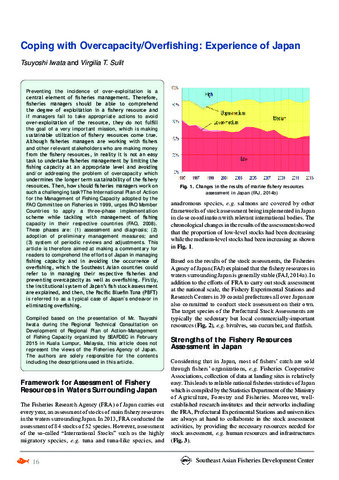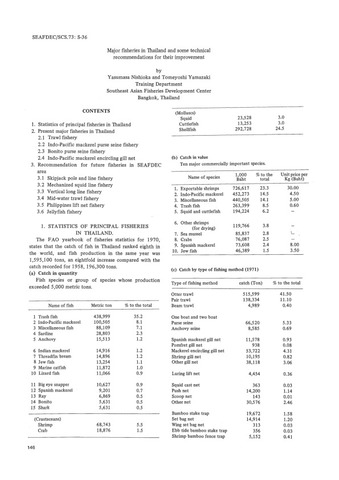Perlihatkan publikasi sederhana
Coping with overcapacity/overfishing: Experience of Japan
Share
| dc.contributor.author | Iwata, Tsuyoshi | |
| dc.contributor.author | Sulit, Virgilia T. | |
| dc.date.accessioned | 2017-11-13T03:28:10Z | |
| dc.date.available | 2017-11-13T03:28:10Z | |
| dc.date.issued | 2016 | |
| dc.identifier.issn | 1685-6546 | |
| dc.identifier.uri | http://hdl.handle.net/20.500.12066/977 | |
| dc.description.abstract | Preventing the incidence of over-exploitation is a central element of fisheries management. Therefore, fisheries managers should be able to comprehend the degree of exploitation in a fishery resource and if managers fail to take appropriate actions to avoid over-exploitation of the resource, they do not fulfill the goal of a very important mission, which is making sustainable utilization of fishery resources come true. Although fisheries managers are working with fishers and other relevant stakeholders who are making money from the fishery resources, in reality it is not an easy task to undertake fisheries management by limiting the fishing capacity at an appropriate level and avoiding and/or addressing the problem of overcapacity which undermines the longer term sustainability of the fishery resources. Then, how should fisheries managers work on such a challenging task? The International Plan of Action for the Management of Fishing Capacity adopted by the FAO Committee on Fisheries in 1999, urges FAO Member Countries to apply a three-phase implementation scheme while tackling with management of fishing capacity in their respective countries (FAO, 2008). These phases are: (1) assessment and diagnosis; (2) adoption of preliminary management measures; and (3) system of periodic reviews and adjustments. This article is therefore aimed at making a commentary for readers to comprehend the efforts of Japan in managing fishing capacity and in avoiding the occurrence of overfishing, which the Southeast Asian countries could refer to in managing their respective fisheries and preventing overcapacity as well as overfishing. Firstly, the institutional system of Japan's fish stock assessment are explained, and then, the Pacific Bluefin Tuna (PBFT) is referred to as a typical case of Japan's endeavor in eliminating overfishing. | en |
| dc.language.iso | en | en |
| dc.publisher | Secretariat, Southeast Asian Fisheries Development Center | en |
| dc.subject | Japan | en |
| dc.title | Coping with overcapacity/overfishing: Experience of Japan | en |
| dc.type | magazineArticle | en |
| dc.citation.volume | 14 | |
| dc.citation.issue | 1 | |
| dc.citation.spage | 16 | |
| dc.citation.epage | 20 | |
| dc.citation.journalTitle | Fish for the People | en |
| dc.subject.asfa | fishing capacity | en |
| dc.subject.asfa | sustainable fishing | en |
| dc.subject.asfa | fishery management | en |
| dc.subject.asfa | stock assessment | en |
| dc.subject.asfa | overfishing | en |
| dc.subject.asfa | tuna fisheries | en |
| dc.subject.asfa | Overcapacity | en |
| dc.subject.asfa | fishery resources | en |




